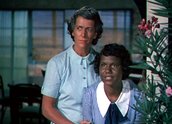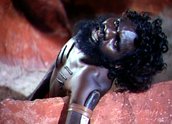


Jedda (1955)
Synopsis
An Aboriginal woman dies in childbirth on a remote cattle station in the Northern Territory. The baby girl is raised by the station owner’s wife, Sarah McMann, after the death of her own child. Jedda (Margaret Dingle) grows up between cultures – forbidden from learning about her own, not fully accepted by the other. Her white mother Sarah (Betty Suttor) wants to 'civilise’ her. Sarah’s husband Doug (George Simpson-Lyttle) believes she will lose her 'pride of race’.
When Jedda is about 16 (now played by Ngarla Kunoth), she becomes fascinated by a tall stranger, Marbuck (Robert Tudawali), a tribal Aboriginal man who arrives from the bush, wanting work. When he abducts Jedda, setting fire to the camp, the head stockman Joe (Paul Reynall) sets off in pursuit. Joe, the son of an Afghan teamster and an Aboriginal woman, is in love with Jedda. He pursues them through crocodile-infested swamps and rugged mountains to Marbuck’s traditional lands, but Marbuck’s own clan has rejected him, for breaking their marriage rules. Jedda is from the wrong 'skin’ group. They sing his death song, but Marbuck defies them. As Joe catches up, Marbuck has become insane. He drags Jedda to a cliff top, determined to take her with him.
Curator’s notes
Jedda is probably Charles Chauvel’s best film, as well as his last. It is historic both for being the first colour feature film made in Australia, but more importantly, because it is arguably the first Australian film to take the emotional lives of Aboriginal people seriously. Chauvel had attempted to create significant Aboriginal characters in some earlier films, notably Uncivilised (1936) in which the warrior Moopil is a strong threat, but the results were uneven, to say the least.
Jedda is a more mature film, in which the emotions of Jedda and Marbuck are given considerable weight. It’s probably fair to say that Chauvel was a man of his time, with a belief in the separation of the races and the primacy of ‘blood’ as the determiner of behaviour. It’s also true that he had an unusual degree of sympathy for, and interest in, Aboriginal culture, partly because of his exposure as a child to Aboriginal families on his grandfather’s property, on the Clarence River. Charles and his wife Elsa, with their 20-year-old daughter Susanne, made a long trip to the Northern Territory in 1950 to research Jedda.
Susanne (Chauvel) Carlsson remembers her father having warm friendships with many Territorians, black and white, including the painter Albert Namatjira. She says three true stories fed into Jedda: the well-known exploits of Nemarluk, an Aboriginal ‘resistance fighter’ who killed three Japanese fisherman near Port Keats in July 1931; the story of a white woman from an isolated station in the Kimberley whose baby died while her husband was away mustering, which meant she had to get permission by radio to bury her own child; and the story of an Aboriginal girl, raised in the city by whites, who ran away and rejoined her people on a holiday in the Northern Territory. Ms Carlsson says the McMann family in the film reflected the views of many white Territorians at the time – not necessarily her father’s own views.
In Jedda, the station owner Doug McMann stresses the ‘wildness’ of Aboriginal blood as a trait that can’t be ‘tamed’; he is against his wife even trying to ‘rescue’ Jedda from her heritage. It’s also true that the same beliefs about blood and heritage have persisted in Australian cinema – notably in The Chant of Jimmie Blacksmith (1978), another film concerned with the ‘problem’ of mixing races, and in Crocodile Dundee (1975 ), where Mick Dundee jokes about being more of a blackfella than his mate Neville, played by David Gulpilil.
Jedda’s race politics are open to multiple interpretations that may be quite separate from what the Chauvels intended (the script was co-written by Charles and his wife Elsa). On one reading, it is a defence of the idea that races should be kept apart, separate and distinct: Jedda’s tragedy is that she is brought up white, apart from her people. By this argument, her Aboriginality is her nature and the years of nurture by a white woman grieving for her own lost child can never change that.
The film never goes far into Jedda’s relationship with her white mother, but the inherent tragedy of it inspired Tracey Moffat’s groundbreaking short film Night Cries (1989), in which an old white woman is cared for by her middle-aged Aboriginal daughter, in an embrace that the Aboriginal daughter can never break, even though she wants to. In other words, the races can never be separated in modern Australia – the mutual dependency of a shared heritage is now too entwined. In a sense, Night Cries is a direct answer to the questions about assimilation posed in Jedda, and the answer is not a happy one.
At the same time, Jedda can be read as a film about the powerful attraction of Aboriginality for white Australians, as well as black. The passion that Marbuck arouses in Jedda is very real and highly sexual and it’s seen mostly from her point of view. The casting of Robert Tudawali – a magnificently proportioned young man with a powerful presence – goes beyond a simple attraction for Jedda. He’s there to arouse the same passions in the audience too. Ngarla Kunoth’s beauty serves the same purpose.
This was a daring idea in a mainstream filmed entertainment in 1955, but Chauvel takes this idea further in the way he treats the landscape. Jedda is full of locations that take one’s breath away; they inspire awe, perhaps more than fear, and the beauty of the Aboriginal characters in that landscape constitutes a kind of longing for Chauvel. It’s as if he wants to enter the land as completely as do his Aboriginal characters. The relationship of white Australians to land is the central preoccupation of his films and it evolves as an idea – from the pioneering subjugation of the land in Heritage (1935), to the more nuanced struggles of the farmers in Sons of Matthew (1949), the film he made before Jedda. Uncivilised and Jedda are about the more romantic attractions of the land as wilderness, a savage Garden of Eden. That’s why colour is so important in Jedda – not just as a question of skin colour, but the colour of the land.
Jedda is partly an expression of Charles Chauvel’s love of his own country, but it’s an equally powerful expression of the idea that Aboriginal Australians had loved it longer, with an intensity that Chauvel seems to have respected.
Secondary curator’s notes
by Romaine MoretonA landmark film in Australian cinema for many reasons, the idea for Jedda was suggested to Chauvel in Manhattan by a reporter for Time magazine. The idea that Chauvel should use Aboriginal people in a film was based on an observation by the reporter that Aboriginal people are unique to Australia and could not be found in Hollywood. The Chauvels searched Aboriginal communities for Aboriginal people who would act in Jedda. They eventually found Robert Tudawali (also known as Bob Wilson) for the role of Marbuck, and Rosalie Kunoth-Monks (also known as Ngarla Kunoth) to play Jedda. Tudawali would act in one more film, called Dust in the Sun, as well as programs for television. A film about his life was made in 1987, called simply Tudawali and starred Ernie Dingo. Indigenous filmmakers commemorate the career of Robert Tudawali, and have named an award after him. The Tudawali Awards are given out to Indigenous filmmakers who continue the filmmaking tradition of people like Robert Tudawali – the first Aboriginal star – and Rosalie Kunoth-Monks. Robert Tudawali moved to Wave Hill in 1965 as a stockman, and was a spokesman for the Gurindji Strike from 1966 – 67. See From Little Things Big Things Grow for more information on the Wave Hill walkout, and the Gurindji peoples’ fight for the return of their land.
Jedda was made during a time when race division was prominent in Australian society, and the narrative is informed by the idea of assimilation, and the forced removal of Aboriginal children from their families by the government in order to 'civilise’ Aboriginal peoples. At the premiere of the film, Aboriginal people were kept separate from white people, with only the two Aboriginal stars allowed to sit with the white folk. A plane carrying footage crashed, and many scenes were lost. As a consequence, the final scenes were filmed in the Blue Mountains, Sydney, with the cliffs painted red to replicate the country in the Northern Territory. Chauvel, one of the most influential filmmakers in Australian history, also made the TV series Australian Walkabout (1959), as well as feature films such as In the Wake of the Bounty (1933).
You can watch an interview with Rosalie Kunoth-Monks at Australian Biography.
- Overview
- Curator’s notes
- Video 3 clips

- Principal credits
- Find a copy
- Make a comment
- Map
- Extras
- Add your review




